Myths about teaching can hold you back


- Year 8
The equation of a straight line
I can appreciate that writing linear equations in the form y = mx + c helps to reveal the structure.


- Year 8
The equation of a straight line
I can appreciate that writing linear equations in the form y = mx + c helps to reveal the structure.
These resources were made for remote use during the pandemic, not classroom teaching.
Switch to our new teaching resources now - designed by teachers and leading subject experts, and tested in classrooms.
Lesson details
Key learning points
- Linear relationships can be written in a variety of algebraic forms.
- It is possible to identify the gradient and y-intercept when the equation is written in the form y=mx+c.
- The m comes from the French "monter" (to climb/ascend) and the c from "commencer" (to start).
- Linear equations can be rearranged in order to reveal the gradient and y-intercept.
Keywords
Equation of a line - Any equation whose graph forms a straight line.
Coefficient - A constant numerical multiplier of the variables in a term.
Constant - A term that does not change; it contains no variables.
Common misconception
Pupils may think graphs are only linear if written in the form y=mx+c
Use the first learning cycle as an opportunity to show graphs in many formats. y=mx+c makes the gradient and y intercept clear.
To help you plan your year 8 maths lesson on: The equation of a straight line, download all teaching resources for free and adapt to suit your pupils' needs...
To help you plan your year 8 maths lesson on: The equation of a straight line, download all teaching resources for free and adapt to suit your pupils' needs.
The starter quiz will activate and check your pupils' prior knowledge, with versions available both with and without answers in PDF format.
We use learning cycles to break down learning into key concepts or ideas linked to the learning outcome. Each learning cycle features explanations with checks for understanding and practice tasks with feedback. All of this is found in our slide decks, ready for you to download and edit. The practice tasks are also available as printable worksheets and some lessons have additional materials with extra material you might need for teaching the lesson.
The assessment exit quiz will test your pupils' understanding of the key learning points.
Our video is a tool for planning, showing how other teachers might teach the lesson, offering helpful tips, modelled explanations and inspiration for your own delivery in the classroom. Plus, you can set it as homework or revision for pupils and keep their learning on track by sharing an online pupil version of this lesson.
Explore more key stage 3 maths lessons from the Graphical representations of linear equations unit, dive into the full secondary maths curriculum, or learn more about lesson planning.

Licence
Prior knowledge starter quiz
6 Questions
Q1.Which equations are represented by the bar model shown?
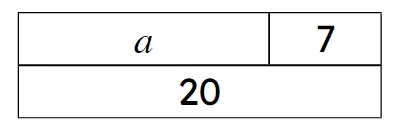
Q2.Fill in the missing value for the $$y$$ intercept of this line $$(0,$$ $$)$$.
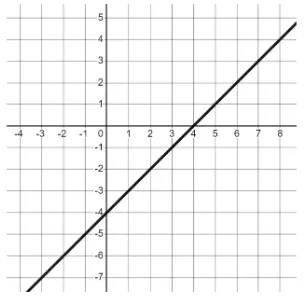
Q3.Match up the coordinate with the relationship it satisfies.
$$(5,1)$$ -
$$x + y = 6 $$
$$(-2,4)$$ -
$$ y = x + 6 $$
$$(8,2)$$ -
$$x - y = 6$$
$$(1,6)$$ -
$$2x + y = 8$$
$$(2,3)$$ -
$$x + 2y = 8 $$
$$(1,3)$$ -
$$ 2x + 2y = 8 $$
Q4.What is the gradient of this line?
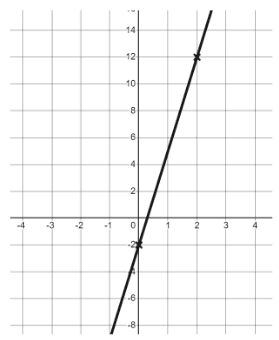
Q5.Match up the expressions containing brackets with their expanded forms.
$$6(x + 4)$$ -
$$6x + 24$$
$$6(2x + 4)$$ -
$$12x + 24$$
$$4(2x + 1)$$ -
$$8x + 4$$
$$4(x + 1)$$ -
$$4x + 4$$
$$2(3x + 2)$$ -
$$6x + 4$$
$$6(2x - 4)$$ -
$$12x - 24$$
Q6.Fill in this coordinate, $$(5,$$ $$)$$, so it satisfies the equation $$2x + 2y = 10$$.
Assessment exit quiz
6 Questions
Q1.Match the keywords to their definitions.
constant -
a term that does not vary
coefficient -
a numerical multiplier of a specific variable in a term
gradient -
a measure of how steep a line is
$$y$$-intercept -
the coordinate where a line crosses the $$y$$ axis
origin -
the coordinate $$(0,0)$$
equation of a straight line -
a relationship which, when plotted, forms a straight line
Q2.Which of these relationships are represented by this bar model?
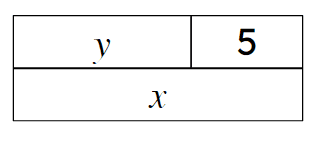
Q3.The graph shows 5 lines labelled A, B, C, D and E. Match the line to its gradient and $$y$$ intercept.
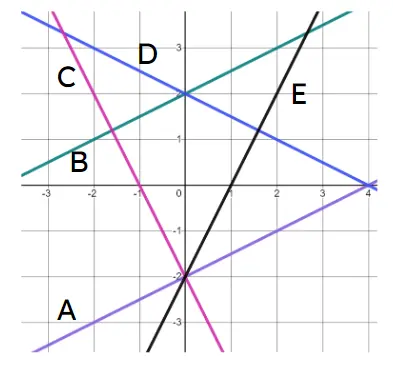
A (purple) -
gradient $$1\over 2$$, $$y$$-intercept $$(0,-2)$$
B (green) -
gradient $$1\over 2$$, $$y$$-intercept $$(0,2)$$
C (pink) -
gradient $$-2$$, $$y$$-intercept $$(0,-2)$$
D (blue) -
gradient $$-{1\over 2}$$, $$y$$-intercept $$(0,2)$$
E (black) -
gradient $$2$$, $$y$$-intercept $$(0,-2)$$
Q4.Match the equations of lines to their key features.
$$y = 5x - 4$$ -
gradient $$5$$, $$y$$-intercept $$(0,-4)$$
$$y = 4 - 5x$$ -
gradient $$-5$$, $$y$$-intercept $$(0,4)$$
$$y = -4x - 5 $$ -
gradient $$-4$$, $$y$$-intercept $$(0,-5)$$
$$ y = 4x + 5 $$ -
gradient $$4$$, $$y$$-intercept $$(0,5)$$
$$y = 5x + 4$$ -
gradient $$5$$, $$y$$-intercept $$(0,4)$$
$$y = 5 - 4x $$ -
gradient $$-4$$, $$y$$-intercept $$(0,5)$$

